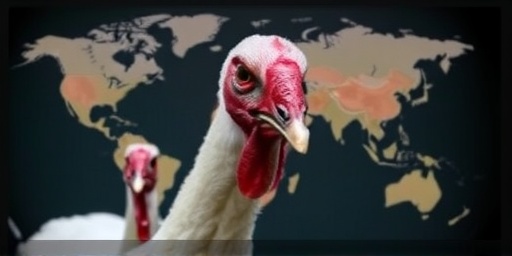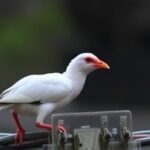In a shocking development that has sent ripples through the global health community, a 62-year-old man from Snohomish County, just outside Seattle, has become the first human worldwide to die from the H5N5 bird flu strain. The Washington death, confirmed by state health officials on Friday, marks not only the inaugural human fatality but also the first documented case of this avian influenza subtype jumping from birds to humans.
- Victim’s Rapid Deterioration Sparks Urgent Investigation
- Health Officials Mobilize After Confirming World’s First H5N5 Human Case
- H5N5 bird flu‘s Zoonotic Leap: From Wild Birds to Human Fatality
- Washington’s Public Health Alert: Precautions and Surveillance Expansion
- Global Implications: Pandemic Watch as H5N5 Surveillance Intensifies
The man, identified only as a backyard poultry enthusiast with no international travel history, sought medical attention last week after experiencing severe respiratory distress. He succumbed to complications including acute pneumonia and multi-organ failure at a local hospital. This incident has prompted an immediate public health alert from the Washington State Department of Health (DOH), urging residents to avoid contact with sick or dead wild birds and to report unusual poultry illnesses.
Victim’s Rapid Deterioration Sparks Urgent Investigation
The patient’s ordeal began subtly with flu-like symptoms—fever, chills, and muscle aches—before escalating dramatically within 48 hours. Hospital records reveal he tested positive for H5N5 via PCR testing on Wednesday, with viral loads indicating a highly aggressive infection. “This was an unusually virulent presentation,” said Dr. Emily Hargrove, the attending pulmonologist. “We’ve seen bird flu before, but H5N5 hit him like a freight train.”
Family members reported the man had been feeding wild waterfowl at a nearby pond two weeks prior, a common pastime in the Pacific Northwest’s wetland-rich areas. No other household members have shown symptoms, but they are under quarantine. Contact tracing has identified 27 potential exposures, including neighbors and farm supply store visitors.
Autopsy results, expedited by the Centers for Disease Control and Prevention (CDC), confirmed H5N5 as the primary cause, with no underlying comorbidities contributing significantly. This H5N5 bird flu case underscores the zoonotic potential of low-pathogenic avian influenza (LPAI) strains evolving in real-time.
Health Officials Mobilize After Confirming World’s First H5N5 Human Case
The Washington State DOH, in coordination with the CDC and World Health Organization (WHO), issued the confirmation late Thursday. “This is a sentinel event,” stated DOH Secretary Umair Shah in a press briefing. “While human-to-human transmission has not been detected, the Washington death elevates H5N5 from a veterinary concern to a human public health threat.”
Surveillance data shows H5N5 circulating in wild birds across North America since early 2023, with outbreaks in commercial poultry flocks in British Columbia and California. The USDA’s Animal and Plant Health Inspection Service (APHIS) reports over 1,200 detections in wild birds this year alone, a 40% increase from 2023. Yet, until now, human infections were absent.
The CDC has elevated its response, dispatching a field team to Washington and activating the Influenza Division’s sequencing labs. Preliminary genomic analysis suggests the virus acquired mammalian adaptation mutations, similar to those seen in the 2022 H5N1 dairy cow spillover events.
Key Timeline of the Outbreak Response
- Day 1 (Last Monday): Patient presents at urgent care with fever (103°F) and cough.
- Day 3: Admitted to ICU; initial flu test negative, but avian panel ordered.
- Day 5: H5N5 confirmed; patient intubated.
- Day 7: Death declared; samples shipped to CDC.
- Day 9: Public announcement and public health alert issued.
H5N5 bird flu‘s Zoonotic Leap: From Wild Birds to Human Fatality
Avian influenza A(H5N5) has been a sporadic player in the bird flu pantheon, primarily affecting wild migratory species like ducks and geese. First identified in wild birds in China in 2021, it spread to Europe and North America via flyways. Unlike the notorious H5N1, which has caused 889 human cases and 463 deaths globally since 2003 (per WHO data), H5N5 was considered low-risk for humans.
Experts attribute the jump to ecological pressures. Climate-driven bird migrations have intensified, crowding susceptible populations. In Washington, over 150,000 poultry have been culled since 2022 due to related H5 strains, per state agriculture reports. “Proximity matters,” explains virologist Dr. Ravi Patel from the Fred Hutchinson Cancer Center. “Backyard flocks and wild birds mixing in suburban areas create perfect spillover zones.”
Symptoms of H5N5 bird flu in humans mirror seasonal flu initially but progress to severe pneumonia, ARDS, and cytokine storms. Fatality rates for related H5 subtypes hover at 50-60% without antivirals like oseltamivir, which was administered here but proved insufficient.
- High-risk groups: Poultry workers, hunters, veterinarians.
- Incubation: 2-7 days.
- Transmission risk: Primarily bird-to-human; human-to-human rare but monitored.
Comparative analysis with H5N8 (which caused a 2021 UK human case) shows H5N5’s hemagglutinin protein binds more efficiently to human receptors, per recent Nature Microbiology preprints.
Washington’s Public Health Alert: Precautions and Surveillance Expansion
In response to the Washington death, Governor Jay Inslee activated emergency protocols, including a statewide public health alert. Residents are advised:
- Avoid touching dead or sick wild birds.
- Cook poultry to 165°F internal temperature.
- Report bird die-offs to 1-800-606-3053.
- Wear PPE if handling birds.
The alert extends to six counties around Seattle, with pop-up testing sites at clinics. Schools near affected wetlands are distributing masks and hand sanitizer. Economically, poultry prices have spiked 15% locally, straining small farmers.
Federally, the CDC recommends enhanced surveillance at wastewater plants and dairy farms, given H5N1’s recent cow transmissions. The USDA is fast-tracking H5 vaccines for poultry, with trials showing 85% efficacy.
Expert Voices on Containment Strategies
“We dodged a bullet with H5N1; H5N5 demands we reload.” – Dr. Angela Rasmussen, Vaccine and Infectious Disease Division, Fred Hutch.
“Global cooperation is key—migrations don’t respect borders.” – WHO Spokesperson Maria Van Kerkhove.
Global Implications: Pandemic Watch as H5N5 Surveillance Intensifies
The H5N5 bird flu fatality reverberates internationally. The WHO has convened an emergency committee, classifying it as a “notable event” under IHR 2005. Europe reports heightened detections in Scandinavia, while Asia sees reassortment risks with seasonal H3N2.
In the U.S., the 1918 pandemic’s shadow looms—H1N1 avian origin killed 50 million. Today, tools like Paxlovid analogs and mRNA platforms offer hope. Moderna announced H5 booster trials last month, aiming for 70% cross-protection.
Economists project $2-5 billion in U.S. ag losses if H5N5 spreads, dwarfing 2022’s $1 billion H5N1 toll. Public sentiment, per a flash Kaiser poll, shows 68% concerned about bird flu, up from 22% pre-event.
Looking ahead, experts call for One Health integration—vet-human collab. Washington’s incident catalyzes funding boosts: $500 million proposed for avian flu readiness in the next farm bill. Testing of 500+ exposed individuals nationwide continues, with genomic tracking via GISAID. If no secondary cases emerge in 21 days, risk downgrades; else, brace for waves.
As fall migration peaks, vigilance peaks too. This Washington death isn’t just a statistic—it’s a clarion call for preparedness in an interconnected world.









